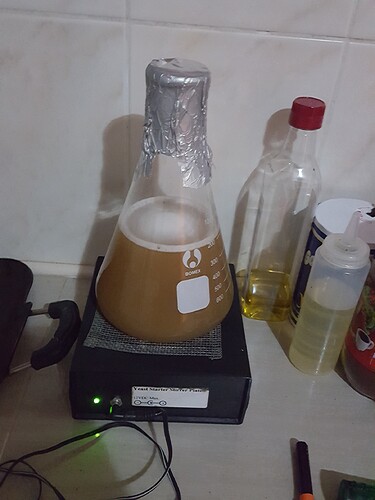I ordered a kit from nb for a coffee stout. The yeast along with the kit was delivered to my house in warm southern California. I put the yeast in and sealed the bucket, but I’ve had no bubbles in the first 48 hours. The first batch of Amber was bubbling by now, but I purchased the yeast from a local store and only spent very few minutes outside of temperature control. Could the yeast be “damaged” by sitting on my stoop for several hours in the heat or just the transportation of the yeast from Minnesota? Thanks Jon.
Did you take the OG of your liquid before pitching? I had a mead that wasn’t very active but after a few days my OG dropped a bit and it started making bubbles. It May be worth giving it a swirl.
Did you pitch a starter?
Just a swing here but I have read somewhere that yeast like to be “Acclimatized” particularly with stronger beers, if you are making a beer with a high OG it may be worth doing a starter and then slowly adding wort until its closer to your batch’s OG and then pitching. I personally have never had issues with stronger beers so I don’t know how much faith to put in that claim but yeast is a living thing so it makes some sense. I have no doubt ill be corrected if im wrong
Was this liquid yeast or dry yeast? Liquid yeast will lose vitality if over heated and not having wort sugars to eat. A starter should be made with liquid yeast even if properly handled and moderate OG worts.
I wouldn’t worry too much if you don’t see bubbling through the air lock when using a bucket fermentor. The lids often don’t seal well letting the CO2 escape around the rim until the fermentation becomes more vigorous. This is not a problem. Some buckets are designed this way and do not have provision for an air lock.
You can pull the air lock and look for krausen formation. Sanitize the area first. You can also hold a bright flash light to the opposite side of the fermentor to see if there is a foamy krausen forming above the liquid.
Let us know if you do or do not see a krausen forming.
Liqued or dry yeast. When in doubt make a starter few days before. Me live in warm climate. So allways make a yeast starter. Few days before brewing. Seems to work. You could allways. Shake the fermentor. And see if you got the yeast going again. Me do use oxygen for about a min. Before i do add. The yeast. Like what flars said check if some krausen going on. If not shake. Tge fermentor and add some more yeast. On the end you can try you got nothing to lose at this point. Or it could be. Not enough yeast. So it did consume all the fermentables and your yeast went dorment
Thank you and everyone else for responses.
It was dry yeast. I will check for foam. I did you a lot of bubbles in my first batch.
Jon
it was dry yeast. what is a starter? Thanks
With dry yeast you got to hydrate the yeast add some water to the yeast. So you get a yeast slurry. Than add to the wort. With a yeast starter. You use liquid yeast. For example. 1 liter water. Add 200 gram dme. Boil this. Cool this in a ice bath. Than add to a flask. Add yeast. And put this on stir plate for. 24 to 32 hours. You create more yeast cells
It doesn’t have to go on a stir plate… Save the money… Shake the living bejesus into the starter/wort, then add the yeast… Do shake it vehemently when ever you go by it… Not dissing a stir plate… just another way to do this… Sneezles61
Dry yeast doesn’t need a starter. Dry yeast is packaged with nutrients that will be depleted if you throw them in a starter. If you have a high OG you can pitch 2 packs.
It also might not be bubbling because you have a leak somewhere and the CO2 is escaping there or, depending on the bubbler, you don’t have enough fluid in it.
THIS^^^
Pop the bucket lid up a little and peak in. See if there’s krauesen.
Thanks for all of the replies. I contacted NB and they told me to pop the lid. There was a little greenish crust just above the beer and it was bubbling! I had to bend the lid in a few places to open it after my first batch. The guy from NB thought that was/is where to CO2 is escaping.
Buckets are famous for not sealing so it looks like you have no worries. When I seal the lid I use either a rubber mallet or the palm of my hand and tap all the way around to try to get it tight then push lightly to the middle of the lid to see if the air lock bubbles. Even that doesn’t always work. It also helps if the gasket is wet. Spray a little Star San on for that.
One nice thing about old fashion glass carboys is that you can see what is going on easily.
